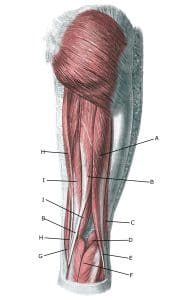Anatomy
There are many muscles around the thigh. The thigh muscles have the primary function of flexing and stretching in the hip and knee joints.

Thighs from the front:
A. Spina iliaca anterior superior
B. M. iliopsoas
C. Lig. inguinal
D. Tuberculum pubicum
E. M. pectineus
F. M. adductor longus
G. M. gracilis
H. M. adductor magnus
I. M. rectus femoris
J. M. sartorius
K. M. vastus medialis
L. Tractus iliotibialis
M. M. vastus lateralis
N. M. tensor fasciae latae et tractus iliotibialis
O. M. gluteus medius
 Knee from behind:
Knee from behind:
M. biceps femoris (caput longum)
M. semitendinosus
Caput breve m. bicipitis femoris
M. plantaris
Tendo m. bicipitis femoris
M. gastrocnemius
M. sartorius
M. gracilis
M. semimembranosus
Cause
Tears and haemorrhages can occur in the thigh muscles if the muscle is subjected to a blow or overload. If a muscle is subjected to a punch, kick or similar, the fleshy and blood vessel-rich part of the muscle is pressed against the bone, causing injury and rupture of muscle fibres and blood vessels.
The rupture and bleeding usually occurs deep in the muscle. In other cases, a larger or smaller muscle tear can occur if the muscle is subjected to an acute overload. Unlike adults, overuse muscle tears are very rare in children.
The bleeding can either break through the muscle membranes and spread over a large area or pool inside the muscle. Muscle haemorrhages in the thigh are often referred to as ‘tears’.
Symptoms
Pain and swelling in the muscle. In some cases, bluish discolouration of the subcutaneous tissue may appear after a few days if the bleeding has broken through the muscle membrane and spread to the subcutaneous tissue.
The pain is aggravated by activating and stretching the muscle and by applying pressure to the muscle.
Examination
Diagnosis is usually made by general clinical examination. If acute thigh pain occurs without a triggering blow or if the discomfort after a blow does not subside quickly, a medical examination should be performed for proper diagnosis and treatment. correct diagnosis and treatment.
The diagnosis is usually made during a general medical examination. If there is any doubt about the diagnosis, ultrasound (UL-Muscle Haemorrhage) or MRI scans can be performed.
In cases of severe pain or sensory disturbances, urgent medical attention is necessary, as in some cases the haemorrhage can cause the pressure in the muscle compartment to rise so much that blood supply and nerves are damaged (acute compartment syndrome). All muscle fillings in children and adolescents should be examined by a doctor (Hu J, et al. 2023).
Treatment
Treatment is primarily relief from pain-inducing activity, stretching and slowly increasing rehabilitation within the pain threshold. For large total haemorrhages, it can sometimes be beneficial to use ultrasound guidance to drain the blood pool. If the haemorrhage is located in the muscles on the inside (vastus medialis) or outside of the thigh (vastus lateralis), rehabilitation is usually faster.
If the haemorrhage is in the middle of the anterior thigh muscle (m vastus intermedius, m rectus femoris), you should expect a longer rehabilitation programme as sudden sprinting, jumping or kicking will put the injured thigh muscle at risk of tearing again.
Complications
If it doesn’t progress smoothly, you should be re-examined (again) and consider whether the diagnosis is correct or if there are complications from the muscle tear.
